NCERT Solutions for Class 4 Maths Chapter-13
NCERT textbook consists of Chapter 13 Fields And Fences which consists of lots of questions in exercise as well as inside the textbook, our experts solved all the questions asked in Tables And Shares as per the CBSE guideline.
What are you going to learn in Chapter 13 Fields And Fences?
Chapter 13 Fields And Fences starts with a farmer and explains the journey of a farmer, and what are the things required to check the dimension of land. You are going to learn type, shape and lots of information related to farming land. What are the different units used to find the area of farming land and how farmers are using all this information to do their work. It is an interesting chapter because you are going to use many concepts which you have gone through in different chapters
Download step by step explanation of NCERT Solutions for Chapter 13 Fields And Fences
1. Rahmat needs to find the length of the boundary of the field. Can you find it from this picture? See the length of each side written near it.

Answer-
We know that
Length of the boundary = 9 + 15 + 21 + 9
= 54 metre
2. Rahmat bought a roll of 70m wire for the fence.
Ganpat – Can you give me the wire that is left out with you? I will use it for my field. How much wire did Rahmat give to Ganpat?
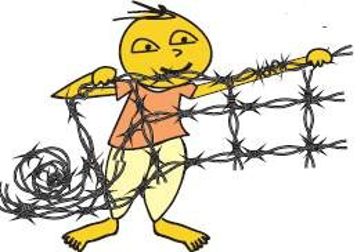
Answer-
It is given that
Total length of wire = 70 m
Length of wire used by Rahmat for boundary = 54 m So the length of wire left out = 70 – 54 = 16 m
Hence, Rahmat gave 16m wire to Ganpat.
NCERT Textbook Page No. - 150
3. Ganpat thanked Rahmat and started fencing his own field. But he needed to get more wire.
(a) How long is the boundary of Ganpat’s field?
(b) How much more wire will Ganpat need for his field?
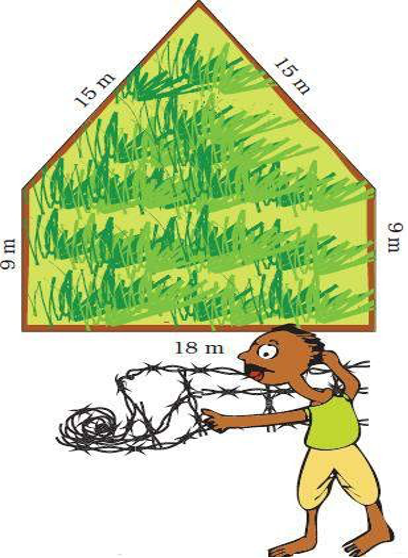
Answer-
(a) Here the length of boundary of Ganpat’s field = 9 + 15 + 15 + 9 + 18
= 66 m
(b) We know that length of boundary of Ganpat’s field = 66 m If Rahmat gave 16m wire to Ganpat
Need of more length of wire = 66 – 16 = 50 m
Hence, Ganpat needs 50 m more wire to boundary his field.
Practice Time
1. Here are pictures of some more fields. Find out which one has the longest boundary.

Answer-
Here we know that length of boundary = 15 + 6 + 15 + 24 = 60 m

Answer-
Here we know that length of boundary = 9 + 6 + 3 + 6 + 6 + 12 = 42 m

Answer-
Here we know that length of boundary = 9 + 12 + 15 = 36 m
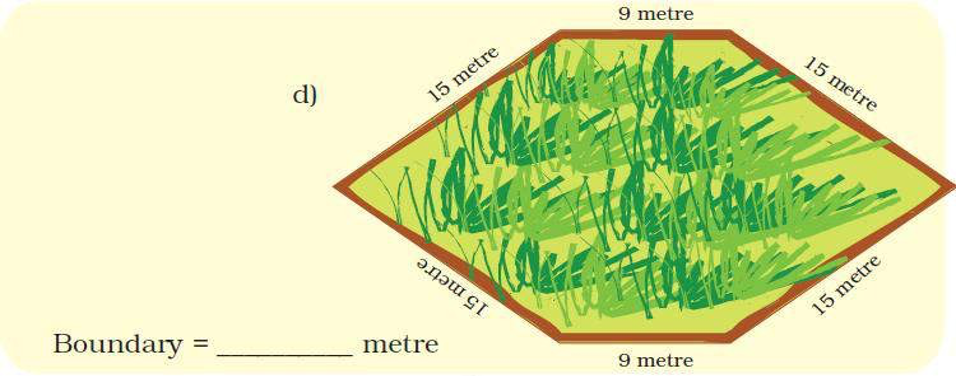
Answer-
Here we know that length of boundary = 15 + 15 + 9 + 15 + 15 + 9 = 78 m Hence, the field (d) has the longest boundary.
NCERT Textbook Page No. - 152
2. Chandu’s father is called the ‘young old man’ in his village. At 70 years of age, he is fully fit. Do you know his secret? He goes for a walk around the field every morning. Everyday he takes four rounds of Chandu’s field.
What is the total distance he covers? 4 × = m = km
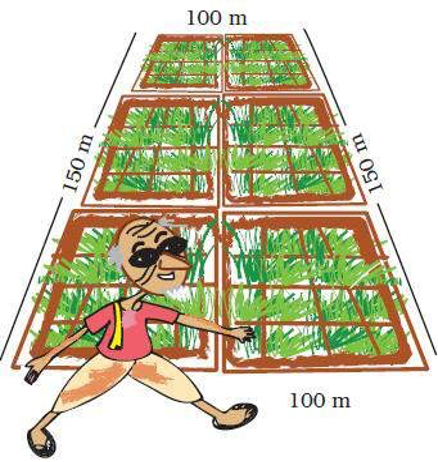
Answer-
We know that the boundary of the field = 150 + 100 + 150 + 100 = 500 m So the distance covered by young old man = 4 × 500 = 2000 m = 2 km
3. Ganpat’s wife works in a tailor’s shop. She has to fix lace around a table cloth. She bought a 100 metre roll of lace.
(a) Look at the picture of the table cloth and tell how much lace is used for one table cloth.
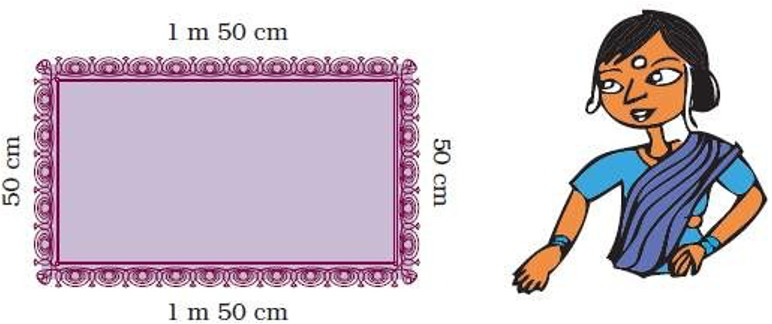
(b) How much lace will be used in 3 such table cloths?
(c) How much lace will be left in the roll? Answer-
(a) We know that
1 m 50 cm = 100 cm + 50 cm = 150 cm
So the length of lace required for one table cloth = 150 + 50 + 150 + 50
= 400 cm = 4 m
(b) We know that the requirement of lace for 1 table cloth = 4 m Requirement of lace for 3 table cloth = 4 × 3 = 12 m
(c) It is given that
Total length of lace = 100 m
Requirement of lace for 3 table cloth = 12 m
Lace left out after making 3 table cloths = 100 – 12 = 88 m
Activity
1. Find out the length of the boundary of these shapes. (Hint:- You can use a thread)
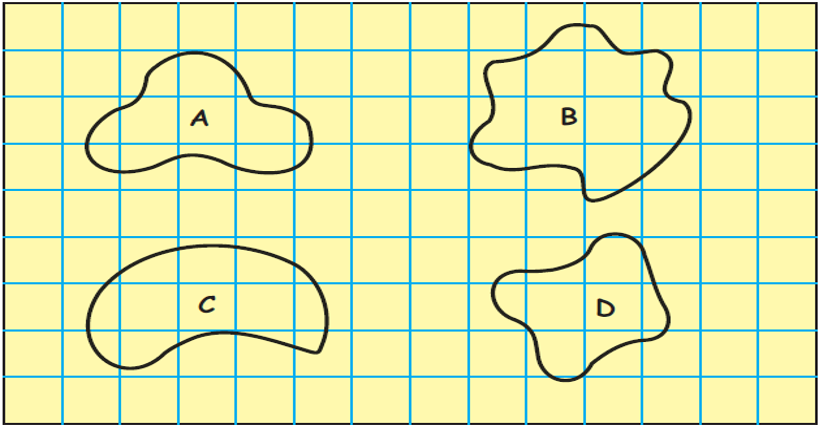
Now count the squares to find out:
(a) How many squares are there in each shape?
(b) Which shape covers the least number of squares?
(c) Which shape covers the most number of squares? Answer-
In order to find the length of the boundary of the shapes given in the figure –
- Take a thread.
- Now place the thread over the figure along boundary.
- Cut the remaining thread which is necessary to cover exactly the boundary of figure.
- Measure the length of the thread.
- Do the same thing with all figures.
(a) We know that
Number of complete squares in figure A = 1 Number of complete squares in figure B = 2 Number of complete squares in figure C = 3 Number of complete squares in figure D = 2
(b) Figure A is the shape which covers the least number of squares which is 1.
(c) Figure C is the shape which covers the most number of squares which is 3.
2. Take a 20 centimentre long thread. Make different shapes by joining the ends. Place on the squared sheet on the next page. Find out:
(a) How many squares are there in each shape?
(b) Which is the biggest shape?
(c) Which is the smallest shape?
(d) How long is the boundary of each shape? Answer-
The different shapes which are done by placing the thread on squared sheet are as follows:
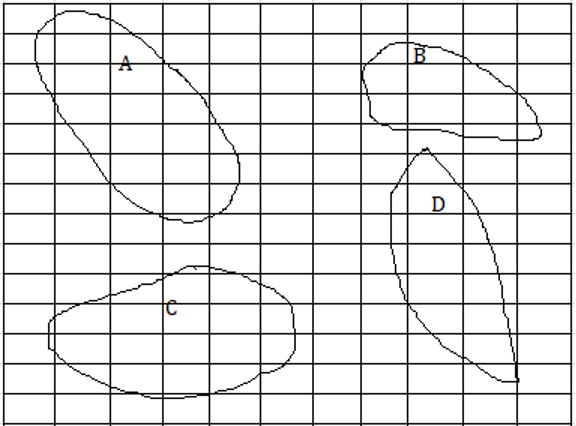
(a) 9 complete squares are present in figure A, 3 complete squares are present in figure B, 6 complete squares are present in figure C and 4 complete squares are present in figure D.
(b) The biggest shape is figure A.
(c) The smallest shape is figure B.
(d) We can measure the boundary of each shape by placing thread along them.
NCERT Textbook Page No. – 154
3. How many different shapes can you make by joining two squares? Draw them on the squared sheet given below. How long is the boundary of each shape?
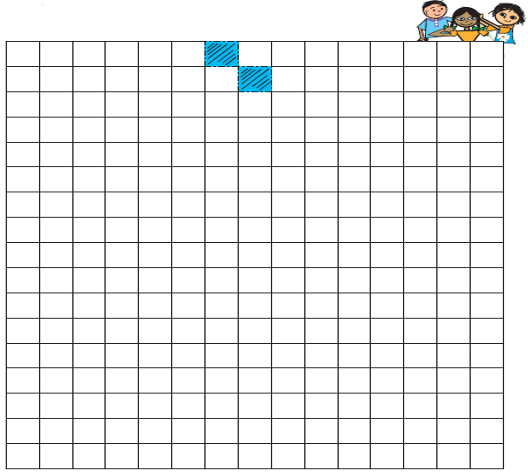
Try this activity with three squares also.
Answer-
The shapes done by joining two squares are given below.
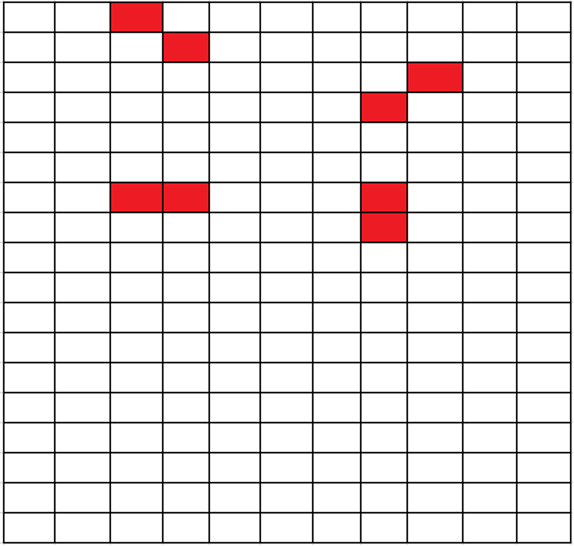
Here four types of shapes can be done by joining two squares. The shapes done by joining three squares are given below.

Here seven types of shapes can be done by joining three squares.
Practice Time
1. A square has a boundary of 12 cm.
(a) From the corner of this square, a small square of side 1 cm is cut off. Will the boundary of B be less or more? Find its length.
(b) If you cut a 1 cm square to get shape C, what will be the length of the boundary of C?
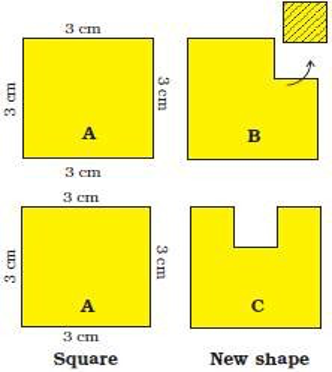
Answer-
(a) We know that the boundary of shape B is equal to the boundary of shape C.
So the boundary of shape B = 12 cm
(b) Here the boundary of shape C will be equal to 14 cm.
2. (a) Find the length of the boundary of square D.
(b)
8 squares of side 1 cm are cut out of the square D. Now it looks like shape E. What is the length of the boundary of shape E?
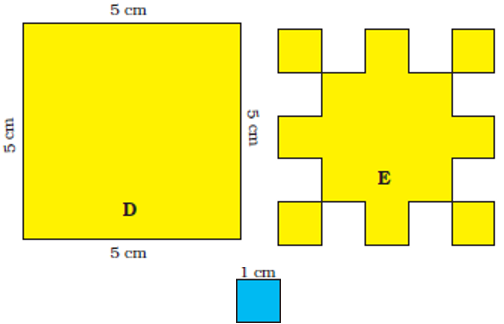
(c) The boundary of this ![]() is _____ + _____ + ___ + ___ Can we also say that the boundary is 4 × 1 cm?
is _____ + _____ + ___ + ___ Can we also say that the boundary is 4 × 1 cm?
Answer-
(a) The length of the boundary of square D = 5 + 5 + 5 + 5 = 20 cm
(b) We know that 21 edges measuring 1 cm of shape E
Therefore, the boundary of shape E = 1 × 21 = 21 cm
(c) The boundary of this ![]() is 1 + 1 + 1 + 1 = 4 cm Here the boundary of
is 1 + 1 + 1 + 1 = 4 cm Here the boundary of ![]() = 4 × 1 cm.
= 4 × 1 cm.
NCERT Textbook Page No. – 156
3. A hockey field is 91 metres 40 cm long and 55 metres wide. How long is the boundary of the field? Answer-
We know that the length of field = 91 m 40 cm It can be written as
= 9100 + 40
= 9140 cm
Width of the held = 55 m = 55 × 100 = 5500 cm
Here
Boundary = length + width + length + width Substituting the values
= 9140 + 5500 + 9140 + 5500
= 29280 cm
= 292 m 80 cm
4. Usha and Valsamma are running a race. Usha is running on the inner circle. Valsamma is running on the outer circle.
Valsamma runs faster than Usha. But still she loses the race. Can you guess why?
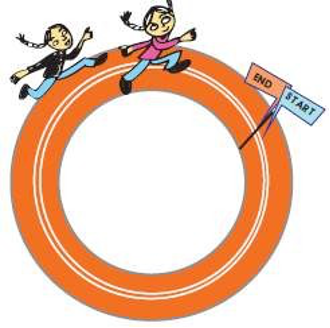
Answer-
We know that the inner cirlce has shorter boundary when compared to the outer circle. Valsamma runs on the outer circle and has to cover more length.
Hence, Valsamma loses the race.
5. Have you seen any race where runners start from different places – like in this picture? Guess why?

Answer-
Yes, I have seen the race which is organized in a circular track. It is made in such a manner to make the distances equal.
School Garden
The students of Class III and IV thought of making a vegetable garden. They chose a place which looked like this.
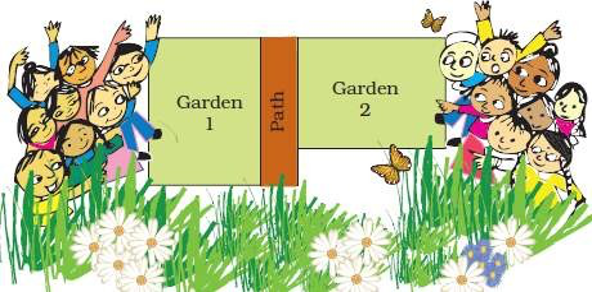
Students of both the classes though that garden 1 was bigger. So both wanted to take garden 1. Suddenly Neetu said
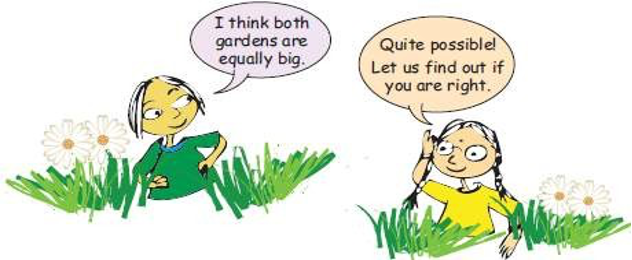
1. How will Neetu find out if the two gardens are equally big? Answer-
First Neetu places a long rope along the boundary of garden 1 to measure the length. Again she places the rope along theboundary of garden 2 to measure the length.
Then she found that the boundaries of both the gardens are equal. Therefore, both the gardens are equal.
Activity
1. Look at the table in your classroom. Guess how many Math-Magic books you can place on it. (Remember – The books should not overlap. Do not leave gaps between the books.)
(a) Write your guess here.
(b) Now check if your guess was right. How many books could you place?
(c) What is the difference between your guess and the actual number of books?
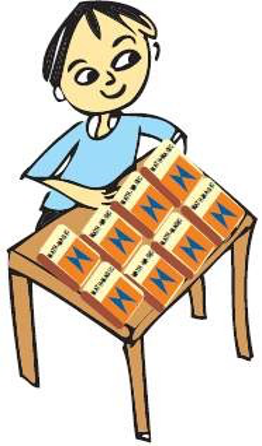
Answer –
(a) 8 Math-Magic books can be placed on the table.
(b) 8 Math-Magic books can be placed on the table.
(c) The difference between your guess and actual number of books is zero.
2. Now look for another table.
(a) Is this table bigger than the last table? Yes/ No
(b) Make a guess how many Math-Magic books can be kept on this table.
(c) Check if your guess was correct.
How many Math-Magic books could you keep?
(d) The difference between the sizes of the two tables is ________ books. Answer-
(a) Yes. This table is bigger than the last table.
(b) 12 Math-Magic books can be kept on this table.
(c) 10 Math-Magic books could be kept on the table.
(d) The difference between the sizes of the two tables is 2 books.
3. (a) How many Math-Magic books can be covered with one sheet of newspaper?
(b) Try covering your Math-Magic book with half a sheet of newspaper.
(c) Can you cover your book with a smaller sheet?
(d) Find the smallest sheet which can cover your book. Check if your friend used a smaller sheet than you did.
Answer-
(a) 4 Math-Magic books can be covered with one sheet of newspaper.
(b) Should be done by the students.
(c) Yes we can cover the book with a smaller sheet.
(d) Should be done by the students.
NCERT Textbook Page No. – 159
4. (a) Which is the biggest leaf in this picture?
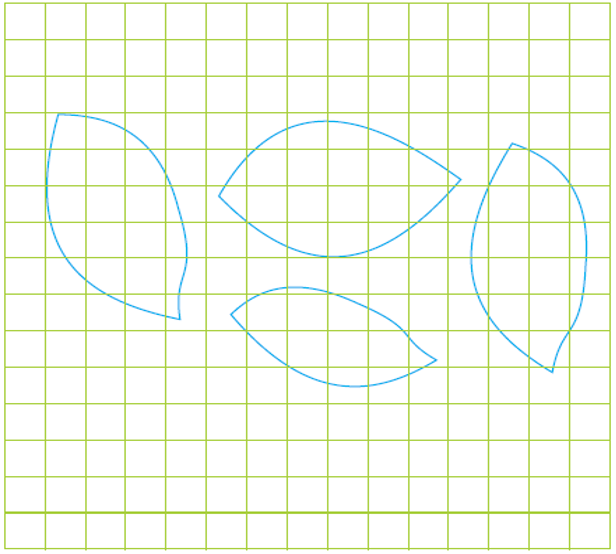
(b) Collect some leaves from the garden. Place each of them here on this squared sheet. Trace out their edges and check how many squares there are in each leaf.
(c) Which is the biggest leaf?
(d) Which is the smallest leaf? Answer-
(a) The biggest leaf in this picture is the leaf in the middle from the top.
(b) Should be done by the students.
(c) Should be done by the students.
(d) Should be done by the students.
NCERT Textbook Page No. – 160
5. (a) How many small squares of size 1 cm are there in this big green square?
(b) Can you think of a faster way to know the total number of small squares without counting each?

Answer-
(a) About 36 small squares of size 1 cm are there in this big green square.
(b) We know that
6 small squares are present at the sides of the big square Total number of small squares = 6 × 6 = 36
6. Guess how many squares of one centimetre can fill this blue rectangle.

Write your guess here.
Check your guess by filling it with small squares. Answer-
Here 32 small squares can fill this blue rectangle.

There are 32 squares and my guessed answer is right.
7. Look at the picture. Can you divide it into 4 equal pieces? Each piece should have the same number of squares.
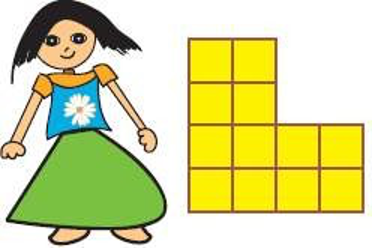
Answer-
Yes we can divide the picture into 4 equal pieces.

Puzzle: A House and the Well Raghavan has a piece of land.
There are 4 houses on his land and in the middel there is a well. He wants to divide this land equally among his four children. Each should get one house and be able to use the well without entering other’s land. Can you help him divide the land?
< Give different colours to each one’s share.
Answer-
The picture below shows how the land can be divided equally among the four children so that each one get one house and is able to use the well without entering other’s land.
















